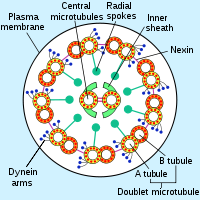
Undulipodium
Encyclopedia

Microtubule
Microtubules are a component of the cytoskeleton. These rope-like polymers of tubulin can grow as long as 25 micrometers and are highly dynamic. The outer diameter of microtubule is about 25 nm. Microtubules are important for maintaining cell structure, providing platforms for intracellular...
array. Both eukaryotic flagella and eukaryotic cilia are considered undulipodia.
Eukaryotic
Eukaryote
A eukaryote is an organism whose cells contain complex structures enclosed within membranes. Eukaryotes may more formally be referred to as the taxon Eukarya or Eukaryota. The defining membrane-bound structure that sets eukaryotic cells apart from prokaryotic cells is the nucleus, or nuclear...
cilia are structurally identical to eukaryotic flagella, although distinctions are sometimes made according to function and/or length.
Flagella use a whip-like action to create movement of the whole cell, such as the movement of sperm
Spermatozoon
A spermatozoon is a motile sperm cell, or moving form of the haploid cell that is the male gamete. A spermatozoon joins an ovum to form a zygote...
in the reproductive tract, and also create water movement as in the choanocyte
Choanocyte
Choanocytes are cells that line the interior of Asconoid, syconoid and leuconoid body type sponges that contain a central flagellum surrounded by a collar of microvilli which are connected by a thin membrane. It is the closest family member to the free-living ancestor called choanoflagellate...
s of sponges.
Motile (or secondary) cilia are more numerous, with multiple cilia per cell, move in a wave-like action, and are responsible for movement in organisms such as ciliates and Platyhelminthes, but also move extracellular substances in animals, such as the ciliary escalator found in the respiratory tract of mammals and the corona of rotifer
Rotifer
The rotifers make up a phylum of microscopic and near-microscopic pseudocoelomate animals. They were first described by Rev. John Harris in 1696, and other forms were described by Anton van Leeuwenhoek in 1703...
s.
Primary cilia function as sensory antennae
Antenna (biology)
Antennae in biology have historically been paired appendages used for sensing in arthropods. More recently, the term has also been applied to cilium structures present in most cell types of eukaryotes....
.
Undulipodia are an extension of the cell membrane
Cell membrane
The cell membrane or plasma membrane is a biological membrane that separates the interior of all cells from the outside environment. The cell membrane is selectively permeable to ions and organic molecules and controls the movement of substances in and out of cells. It basically protects the cell...
containing both cytoplasm
Cytoplasm
The cytoplasm is a small gel-like substance residing between the cell membrane holding all the cell's internal sub-structures , except for the nucleus. All the contents of the cells of prokaryote organisms are contained within the cytoplasm...
and a regular arrangement of microtubules known as an axoneme
Axoneme
Numerous eukaryotic cells carry whip-like appendages whose inner core consists of a cytoskeletal structure called the axoneme....
. At the base of the extension lies a structure called the kinetosome or basal body
Basal body
A basal body is an organelle formed from a centriole, and a short cylindrical array of microtubules. It is found at the base of a eukaryotic undulipodium and serves as a nucleation site for the growth of the axoneme microtubules...
which is attached via motor proteins to the microtubules. The kinetosome mediates movement through a chemical reaction, causing the microtubules to slide against one another and the whole structure to bend.

